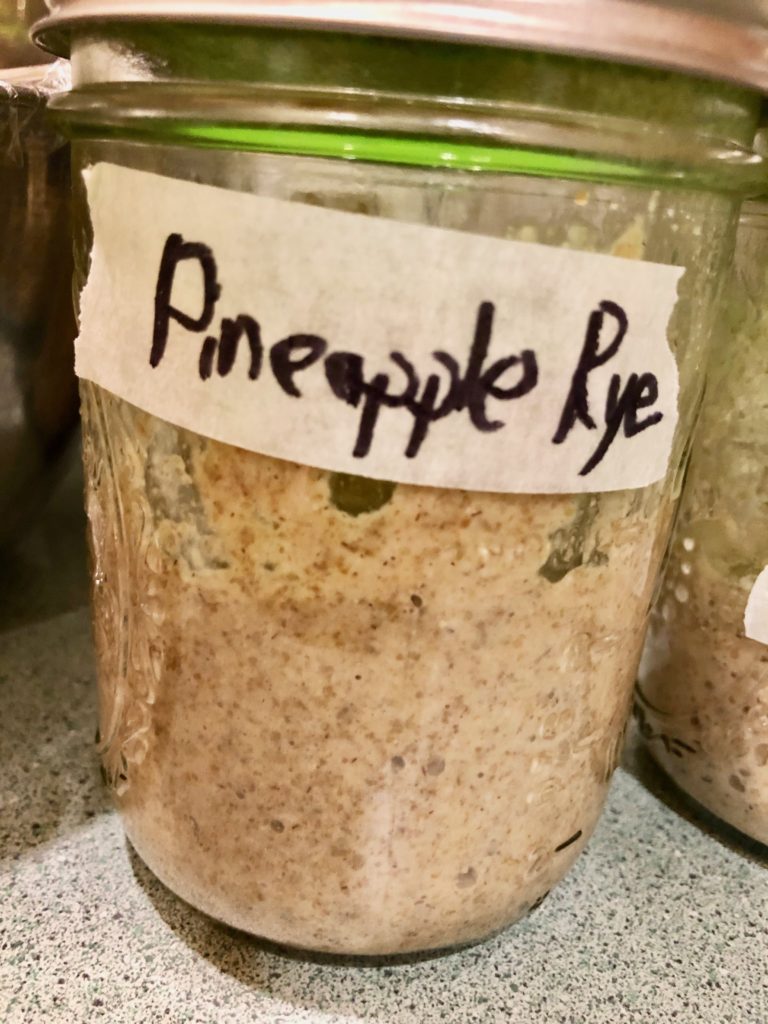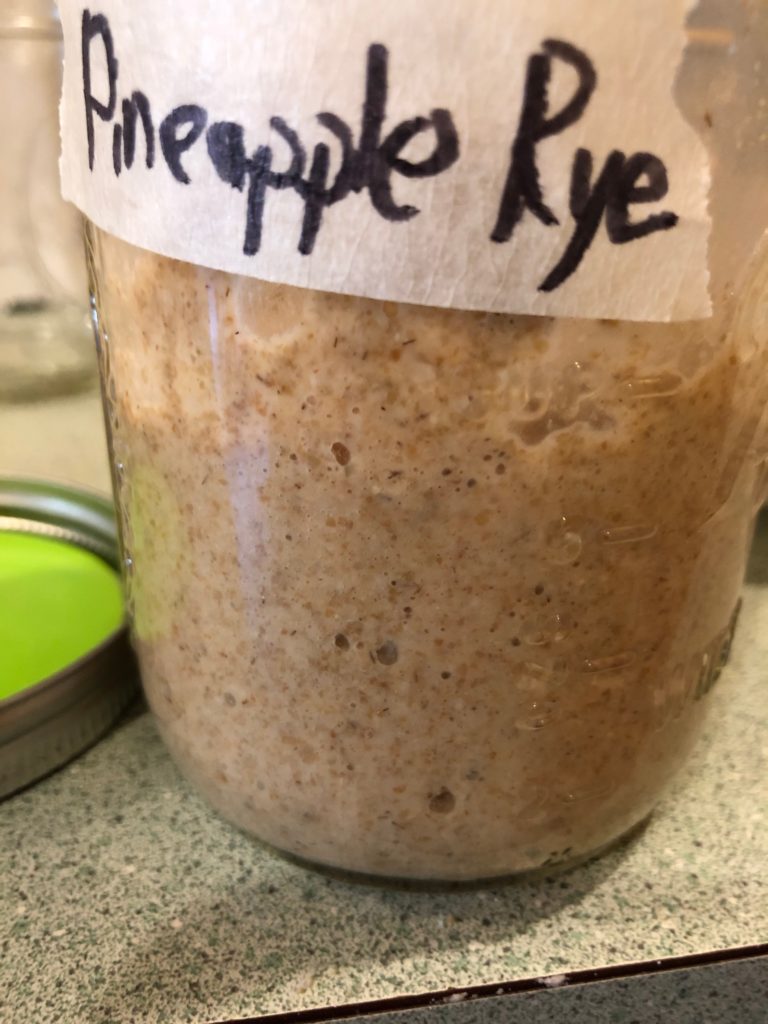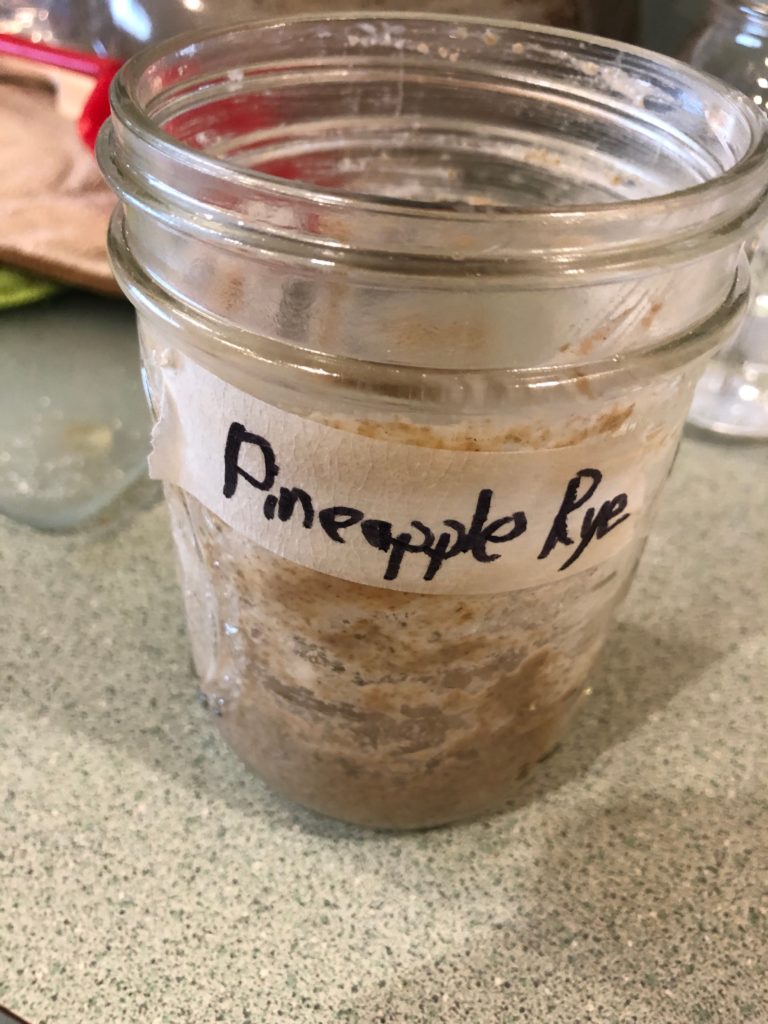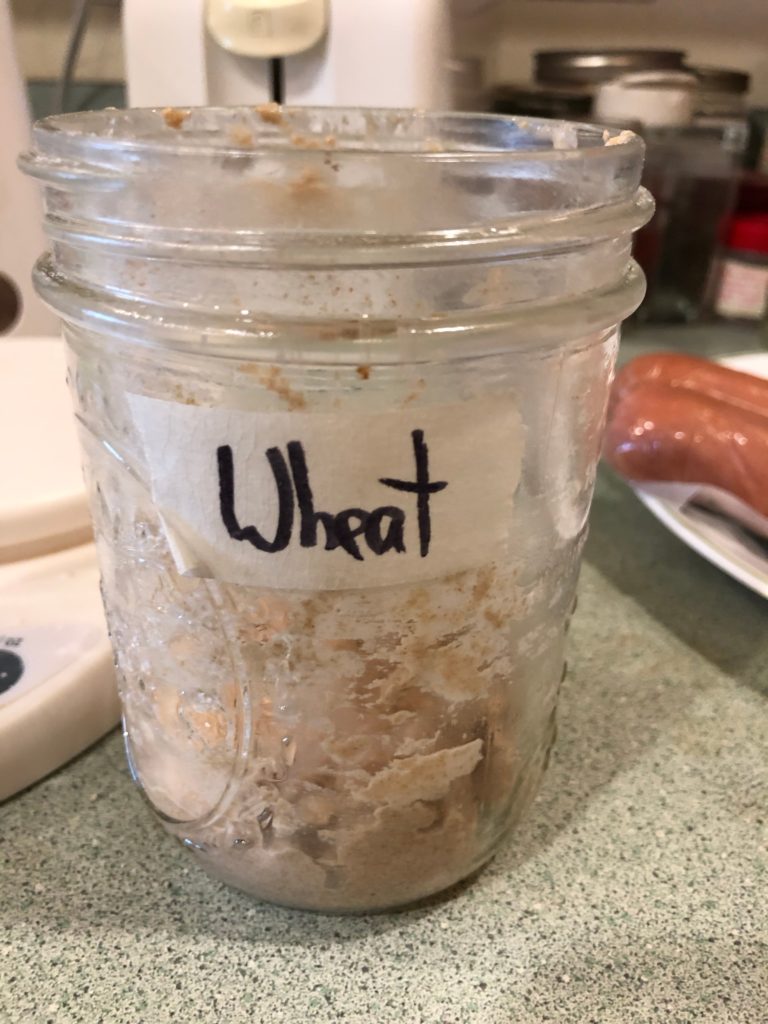Recap of Days 1-2 here. This got long so I made you a Table of Contents. There will be a follow-up post on maintenance of a mature starter and another on baking with it once my baby starters are ready.
Table of Contents
- Day 3 for Me
- Day 4 for Me
- Day 5 for Me
- Day 6 for Me
- Recommendations for You for the Next week
- When will it be ready to bake with?
Day 3
Saturday, April 4th

Starter 1 (wheat) was very active with large bubbles; it smelled clean and unlike any of the unwanted bacteria I was concerned about. This is a good sign. It probably took 24 hours for it to rise and and fall partway. I added 1 oz whole wheat and 1 oz water as before.
Starter 2 (pineapple rye) was less active. There were small bubbles visible but not much of a rise and fall. I wonder if this rye flour is just less nutritious than the one I normally use (which is completely out in all the grocery stores around here). Mr Sticky has had smaller bubbles than usual and 50% of what I maintain him with is also this same rye flour. I added 1 0z whole rye flour and 1 oz pineapple juice as before.
Day 4
Sunday April 5th


Starter 1 (wheat) was very active again and still smelled clean. I added 1 oz water & 1 oz whole wheat flour as before.
Starter 2 (pineapple rye) again showed less activity, but did have small bubbles. I added 1 oz pineapple juice and 1 oz whole rye flour as before.
Day 5
Monday April 6th

Starter 1 (wheat) was very active again and still smelled clean. Starter 2 (pineapple rye) again with the small bubbles. The pineapple juice method is not working as a jump start for me so well.
At this point I would like to reduce the volume of starter in the jar and reduce the waste products the new colonies are in a little bit. Notice that bit of liquid under most of the wheat starter? It’s been producing extra liquid a lot. That’s a waste product from the yeast and if you let it build up eventually they will die in their own waste. (Do you want to live in your own urine and feces? I didn’t think so.) We left the waste products in for the first few days because we wanted the acid the lactobacilli were making to alter the ph of the overall environment to encourage our yeast to activate.

pineapple rye starter before refreshment 
P.R. after refreshment 
P.R. after refreshment 
Wheat starter before refreshment 
Wheat after refreshement 
Wheat after refreshement
I tossed out a large portion of both baby starters. Starter 1 (wheat) I retained 1 oz, to which I added 1 oz whole wheat flour and 1 0z water. Starter 2 (pineapple) I retained 1 oz, to which I added 1 oz whole rye flour and 1 oz WATER. You’re not going to use pineapple juice forever.
Day 6
Tuesday April 7th
I have not yet refreshed the baby starters. (Mr Sticky was fed up for refrigeration and put away yesterday after I got a dough going from him.) They both show only very small bubbles – I may have gone a bit overboard in how much I removed yesterday. I also refreshed them pretty late yesterday so I’m going to wait and see what they are doing after dinner. I may just add to them if they haven’t really gotten as active as I’d like.
Recommendations for the next week
Keep refreshing your starters every day around the same time. At this point, you do want to remove some of your existing matter when you refresh. I recommend a 1:1:1 ratio by weight for now- so if you save 2 oz of starter, add 2 oz of flour and 2 oz of water. For now, I wouldn’t go below 1 oz saved, and 2 oz is probably better.
If you are seeing activity (bubbles, a clear rise and fall) then you are moving towards a ready culture. You may want to move to twice daily refreshments if the peak of the activity is happening quickly and your starter is mostly fallen back down to flat by the time you’re ready to refresh. (Temperature will strongly affect this. If your kitchen is over 75*F I highly recommend twice daily refreshments.) Your goal is to be refreshing not long after the peak, definitely before it’s all the way back to flat.
Assess your culture by checking the smell. It should smell like flour, a little sour (from the acid) and little funky from the yeast. If you’ve had an unfiltered wheat beer or brewed you probably know what the yeast funk I’m talking about is. Mr Sticky has particular smell that I call “feety but good” when it’s active. Foul smells can indicate unwanted bacteria and a culture that is not ready yet.
You can also start to mix in some all-purpose flour at this point rather than maintaining on all whole-grain. My personal preference is not to go below 50% all-grain flour at any time, but plenty of people maintain their starter cultures completely on AP flour. I would wait until you have a predictable rise and fall to switch over completely from whole-grain to all purpose.
What about all that stuff I’m tossing?
At this point you most likely do not have unwanted bacteria (check the smell) and you can actually use that extra starter mass instead of throwing it out. It can add a sour flavor to a baked good (although it’s probably not powerful enough to give it a full rise yet). I like King Arthur Flour’s recipes for sourdough discard, especially these biscuits. If you refrigerate your discard you can save it for up to a week, so you could keep a big jar of discard that you add to until you have enough for a discard recipe. (DO NOT leave it out at room temperature – it will be invaded by MOLD!) I have done this occasionally.
When will it be ready to bake with?
The big question! What you want to see is activity in the form of bubbles and a clear, predictable rise and fall cycle. Refreshing at 1:1:1, twice daily, you want to see this rise and fall cycle happen within 12 hours. If you have this, and it doesn’t smell rotten, you are probably good to bake!
So what to bake? This will really depend on what flour you have available, your previous bread baking experience and comfort, and the equipment you have available. I plan to do another post with video about baking with sourdough when my baby starters are ready to go. In the meantime, if your starter is roaring to go, try this Rustic Sourdough Bread recipe from King Arthur Flour. It should work with any wheat flour you have on hand.
Go forth and sourdough!
